Safety and risk management at Kenoss Contractors Name: Course Description
VerifiedAdded on 2022/10/17
|14
|2942
|253
AI Summary
It discusses safety at workplace, breaches of safety law that led to the incident and changing efforts as a result, different actions that could be implemented to stop the incident from taking place and ways of addressing this issue to maintain safety systems in this workplace. Contents Introduction 4 First: Safety at workplace 5 Second: Safety breaches that led to the incident and evidence of changes as a result 5 Third: What could have been done differently to prevent this incident from occurring 7 Fourth: Ways of addressing this issue to
Contribute Materials
Your contribution can guide someone’s learning journey. Share your
documents today.
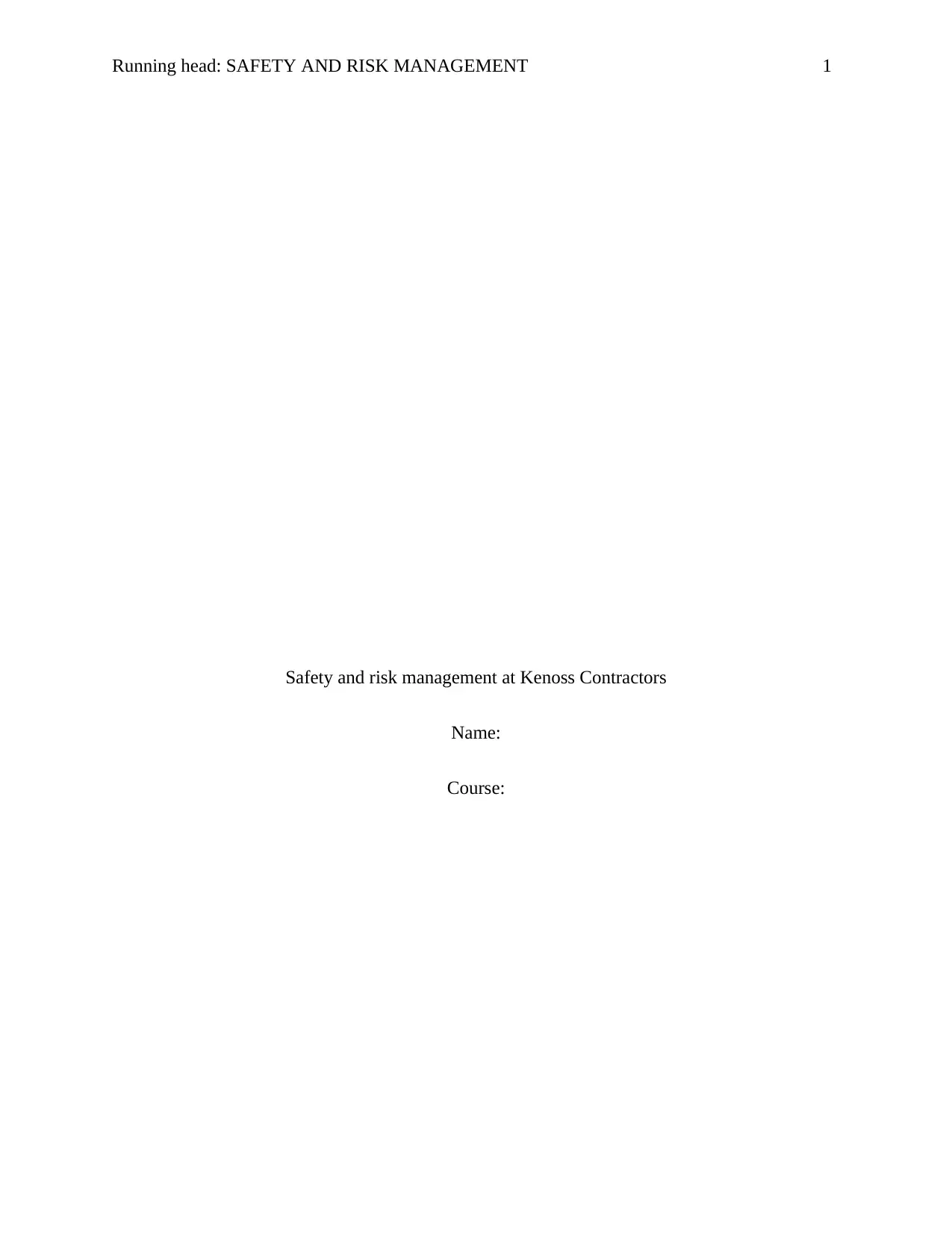
Running head: SAFETY AND RISK MANAGEMENT 1
Safety and risk management at Kenoss Contractors
Name:
Course:
Safety and risk management at Kenoss Contractors
Name:
Course:
Secure Best Marks with AI Grader
Need help grading? Try our AI Grader for instant feedback on your assignments.
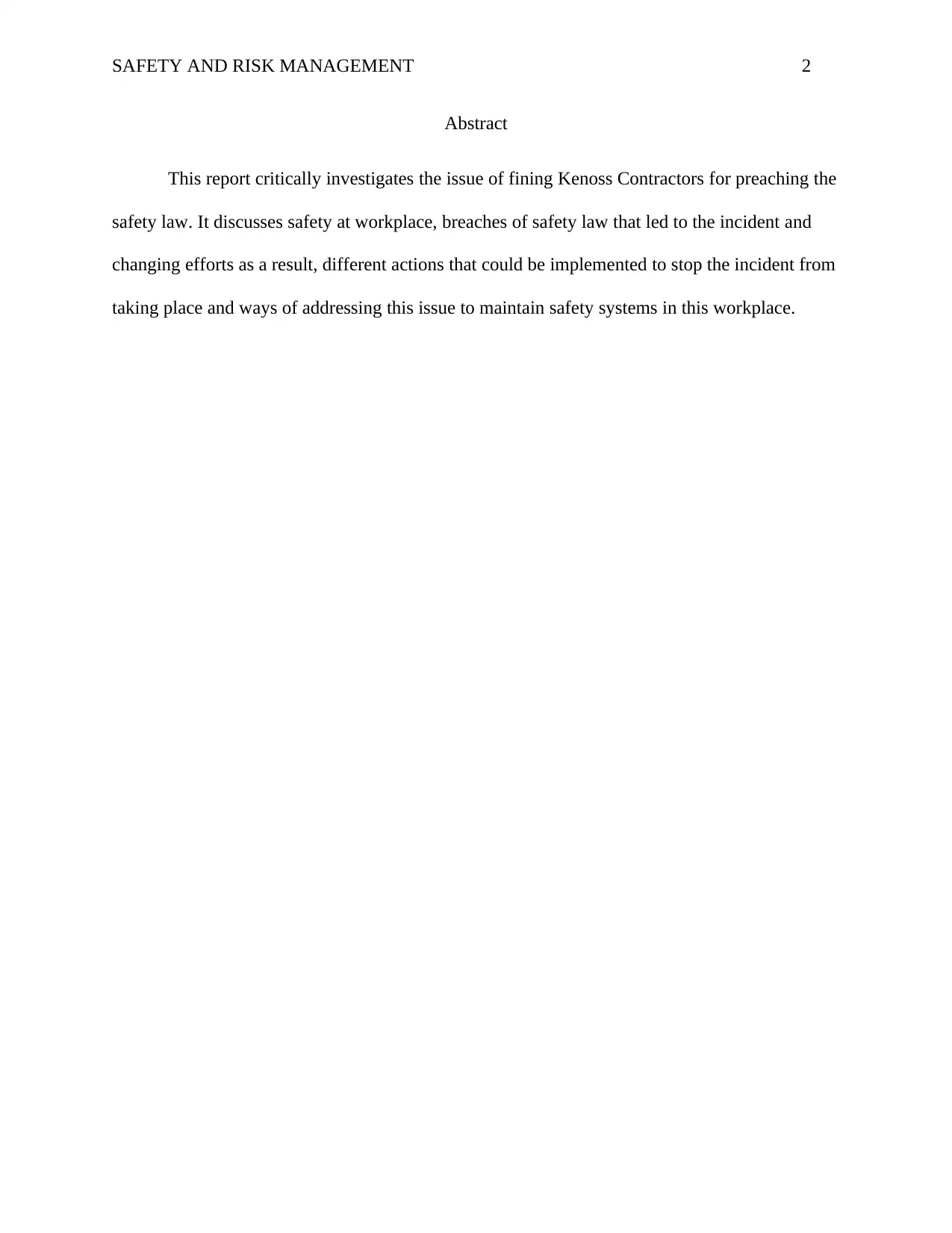
SAFETY AND RISK MANAGEMENT 2
Abstract
This report critically investigates the issue of fining Kenoss Contractors for preaching the
safety law. It discusses safety at workplace, breaches of safety law that led to the incident and
changing efforts as a result, different actions that could be implemented to stop the incident from
taking place and ways of addressing this issue to maintain safety systems in this workplace.
Abstract
This report critically investigates the issue of fining Kenoss Contractors for preaching the
safety law. It discusses safety at workplace, breaches of safety law that led to the incident and
changing efforts as a result, different actions that could be implemented to stop the incident from
taking place and ways of addressing this issue to maintain safety systems in this workplace.
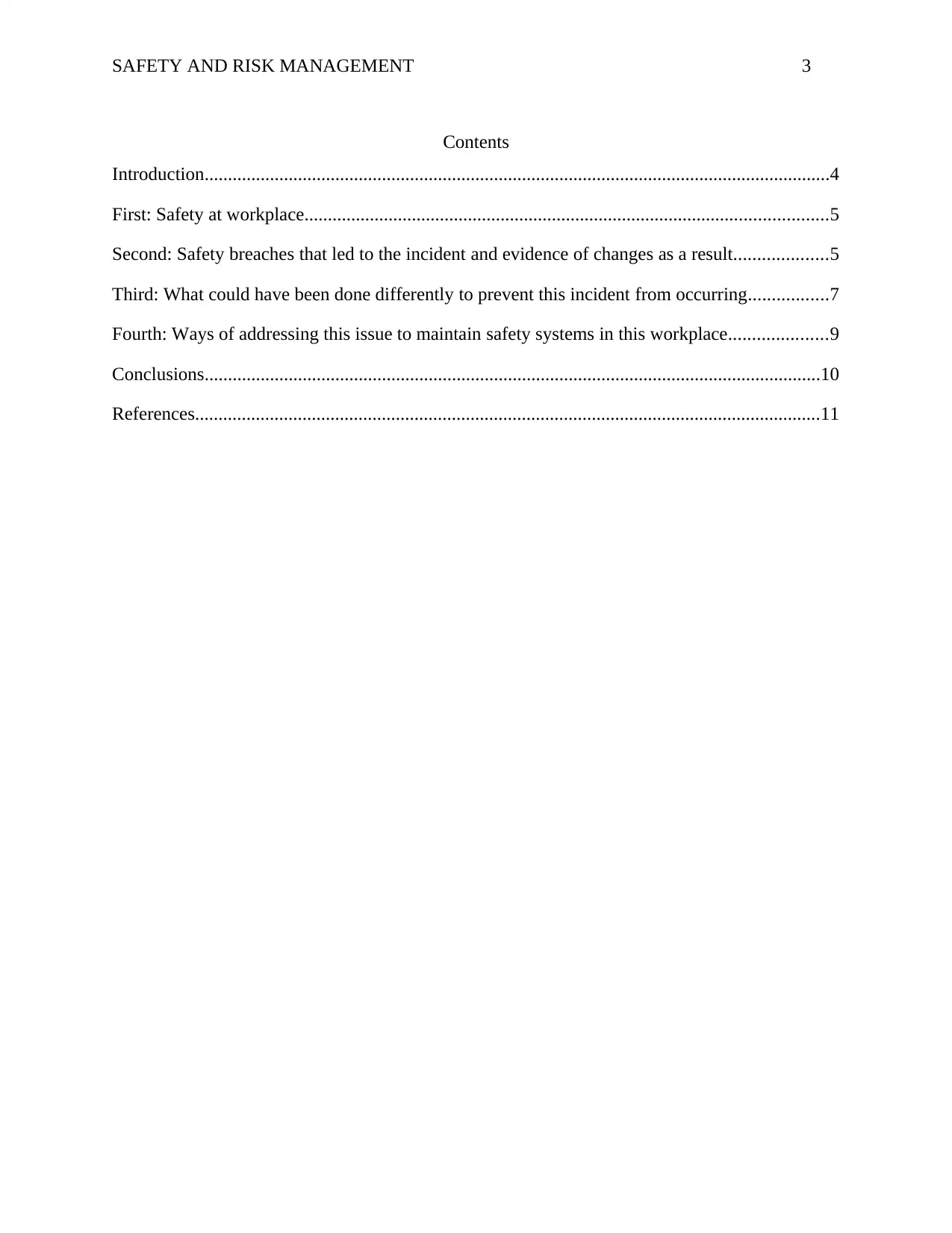
SAFETY AND RISK MANAGEMENT 3
Contents
Introduction......................................................................................................................................4
First: Safety at workplace................................................................................................................5
Second: Safety breaches that led to the incident and evidence of changes as a result....................5
Third: What could have been done differently to prevent this incident from occurring.................7
Fourth: Ways of addressing this issue to maintain safety systems in this workplace.....................9
Conclusions....................................................................................................................................10
References......................................................................................................................................11
Contents
Introduction......................................................................................................................................4
First: Safety at workplace................................................................................................................5
Second: Safety breaches that led to the incident and evidence of changes as a result....................5
Third: What could have been done differently to prevent this incident from occurring.................7
Fourth: Ways of addressing this issue to maintain safety systems in this workplace.....................9
Conclusions....................................................................................................................................10
References......................................................................................................................................11
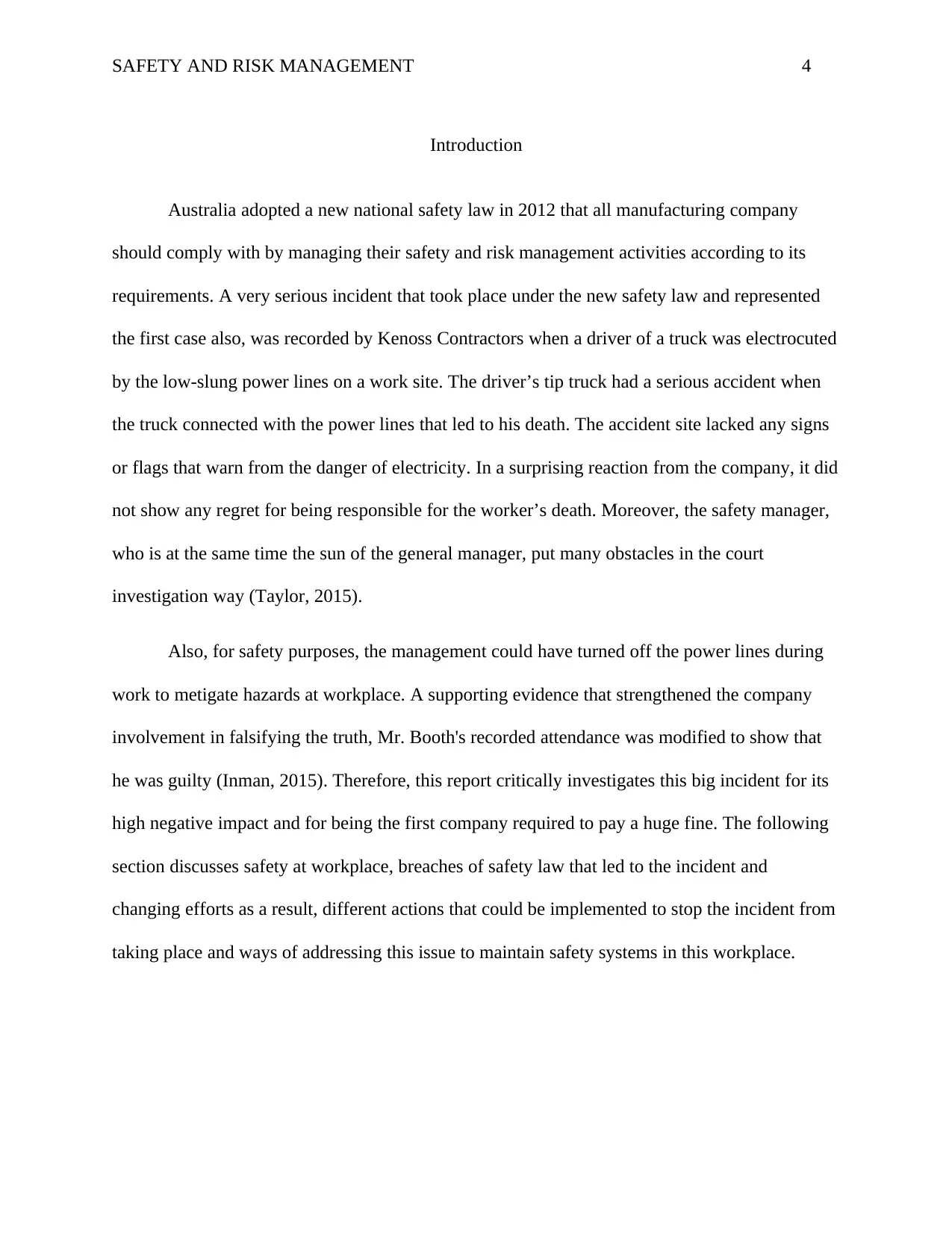
SAFETY AND RISK MANAGEMENT 4
Introduction
Australia adopted a new national safety law in 2012 that all manufacturing company
should comply with by managing their safety and risk management activities according to its
requirements. A very serious incident that took place under the new safety law and represented
the first case also, was recorded by Kenoss Contractors when a driver of a truck was electrocuted
by the low-slung power lines on a work site. The driver’s tip truck had a serious accident when
the truck connected with the power lines that led to his death. The accident site lacked any signs
or flags that warn from the danger of electricity. In a surprising reaction from the company, it did
not show any regret for being responsible for the worker’s death. Moreover, the safety manager,
who is at the same time the sun of the general manager, put many obstacles in the court
investigation way (Taylor, 2015).
Also, for safety purposes, the management could have turned off the power lines during
work to metigate hazards at workplace. A supporting evidence that strengthened the company
involvement in falsifying the truth, Mr. Booth's recorded attendance was modified to show that
he was guilty (Inman, 2015). Therefore, this report critically investigates this big incident for its
high negative impact and for being the first company required to pay a huge fine. The following
section discusses safety at workplace, breaches of safety law that led to the incident and
changing efforts as a result, different actions that could be implemented to stop the incident from
taking place and ways of addressing this issue to maintain safety systems in this workplace.
Introduction
Australia adopted a new national safety law in 2012 that all manufacturing company
should comply with by managing their safety and risk management activities according to its
requirements. A very serious incident that took place under the new safety law and represented
the first case also, was recorded by Kenoss Contractors when a driver of a truck was electrocuted
by the low-slung power lines on a work site. The driver’s tip truck had a serious accident when
the truck connected with the power lines that led to his death. The accident site lacked any signs
or flags that warn from the danger of electricity. In a surprising reaction from the company, it did
not show any regret for being responsible for the worker’s death. Moreover, the safety manager,
who is at the same time the sun of the general manager, put many obstacles in the court
investigation way (Taylor, 2015).
Also, for safety purposes, the management could have turned off the power lines during
work to metigate hazards at workplace. A supporting evidence that strengthened the company
involvement in falsifying the truth, Mr. Booth's recorded attendance was modified to show that
he was guilty (Inman, 2015). Therefore, this report critically investigates this big incident for its
high negative impact and for being the first company required to pay a huge fine. The following
section discusses safety at workplace, breaches of safety law that led to the incident and
changing efforts as a result, different actions that could be implemented to stop the incident from
taking place and ways of addressing this issue to maintain safety systems in this workplace.
Secure Best Marks with AI Grader
Need help grading? Try our AI Grader for instant feedback on your assignments.
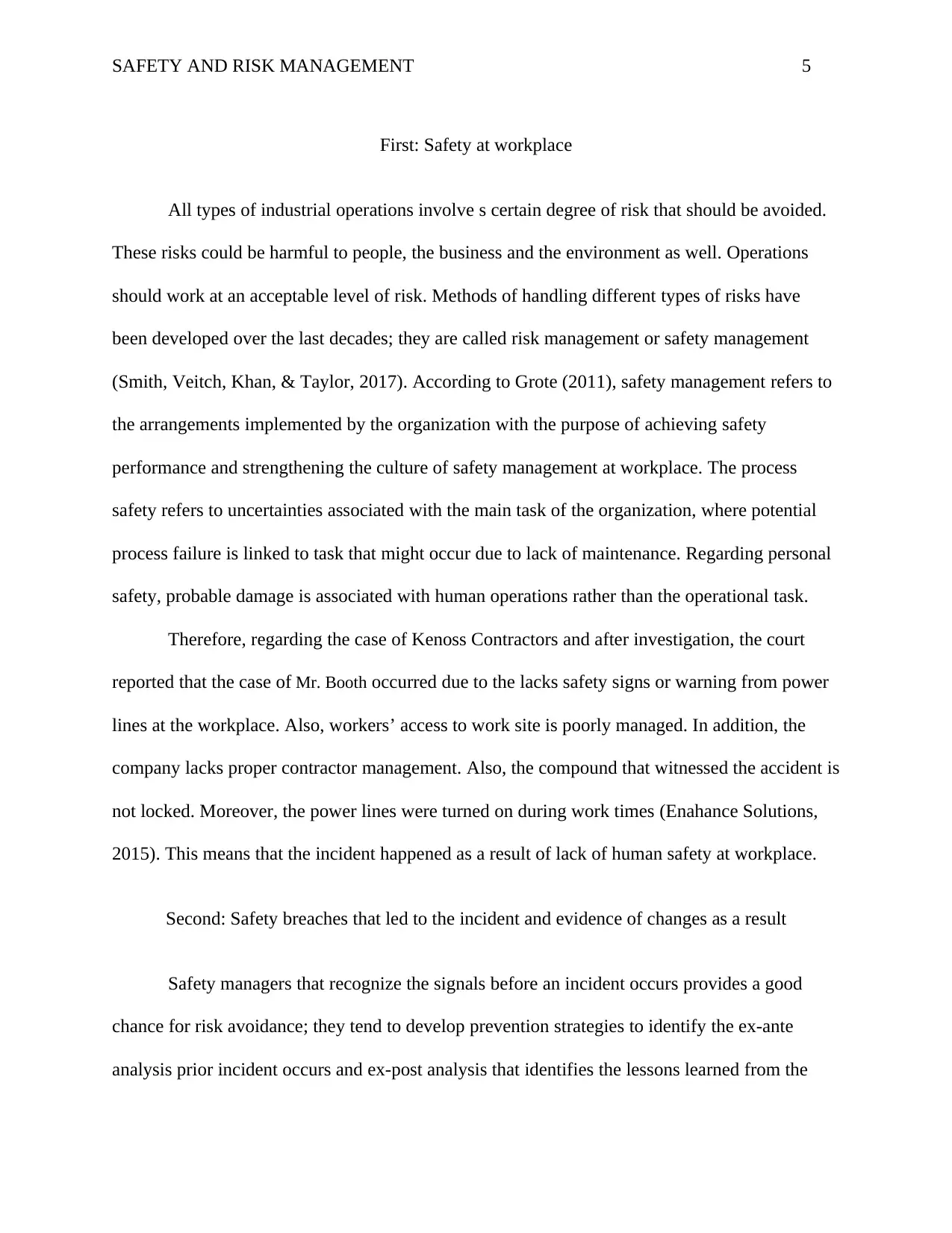
SAFETY AND RISK MANAGEMENT 5
First: Safety at workplace
All types of industrial operations involve s certain degree of risk that should be avoided.
These risks could be harmful to people, the business and the environment as well. Operations
should work at an acceptable level of risk. Methods of handling different types of risks have
been developed over the last decades; they are called risk management or safety management
(Smith, Veitch, Khan, & Taylor, 2017). According to Grote (2011), safety management refers to
the arrangements implemented by the organization with the purpose of achieving safety
performance and strengthening the culture of safety management at workplace. The process
safety refers to uncertainties associated with the main task of the organization, where potential
process failure is linked to task that might occur due to lack of maintenance. Regarding personal
safety, probable damage is associated with human operations rather than the operational task.
Therefore, regarding the case of Kenoss Contractors and after investigation, the court
reported that the case of Mr. Booth occurred due to the lacks safety signs or warning from power
lines at the workplace. Also, workers’ access to work site is poorly managed. In addition, the
company lacks proper contractor management. Also, the compound that witnessed the accident is
not locked. Moreover, the power lines were turned on during work times (Enahance Solutions,
2015). This means that the incident happened as a result of lack of human safety at workplace.
Second: Safety breaches that led to the incident and evidence of changes as a result
Safety managers that recognize the signals before an incident occurs provides a good
chance for risk avoidance; they tend to develop prevention strategies to identify the ex-ante
analysis prior incident occurs and ex-post analysis that identifies the lessons learned from the
First: Safety at workplace
All types of industrial operations involve s certain degree of risk that should be avoided.
These risks could be harmful to people, the business and the environment as well. Operations
should work at an acceptable level of risk. Methods of handling different types of risks have
been developed over the last decades; they are called risk management or safety management
(Smith, Veitch, Khan, & Taylor, 2017). According to Grote (2011), safety management refers to
the arrangements implemented by the organization with the purpose of achieving safety
performance and strengthening the culture of safety management at workplace. The process
safety refers to uncertainties associated with the main task of the organization, where potential
process failure is linked to task that might occur due to lack of maintenance. Regarding personal
safety, probable damage is associated with human operations rather than the operational task.
Therefore, regarding the case of Kenoss Contractors and after investigation, the court
reported that the case of Mr. Booth occurred due to the lacks safety signs or warning from power
lines at the workplace. Also, workers’ access to work site is poorly managed. In addition, the
company lacks proper contractor management. Also, the compound that witnessed the accident is
not locked. Moreover, the power lines were turned on during work times (Enahance Solutions,
2015). This means that the incident happened as a result of lack of human safety at workplace.
Second: Safety breaches that led to the incident and evidence of changes as a result
Safety managers that recognize the signals before an incident occurs provides a good
chance for risk avoidance; they tend to develop prevention strategies to identify the ex-ante
analysis prior incident occurs and ex-post analysis that identifies the lessons learned from the
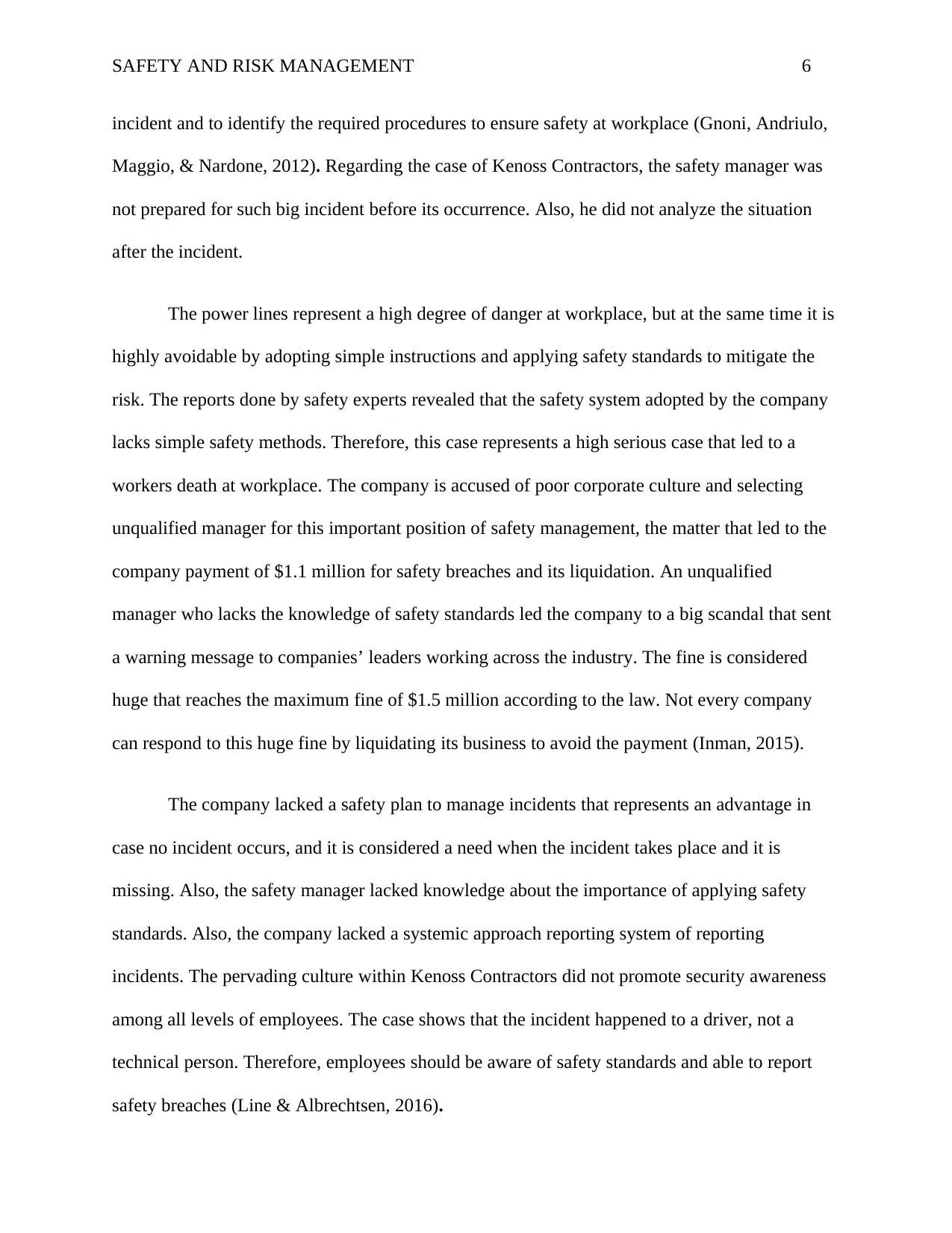
SAFETY AND RISK MANAGEMENT 6
incident and to identify the required procedures to ensure safety at workplace (Gnoni, Andriulo,
Maggio, & Nardone, 2012). Regarding the case of Kenoss Contractors, the safety manager was
not prepared for such big incident before its occurrence. Also, he did not analyze the situation
after the incident.
The power lines represent a high degree of danger at workplace, but at the same time it is
highly avoidable by adopting simple instructions and applying safety standards to mitigate the
risk. The reports done by safety experts revealed that the safety system adopted by the company
lacks simple safety methods. Therefore, this case represents a high serious case that led to a
workers death at workplace. The company is accused of poor corporate culture and selecting
unqualified manager for this important position of safety management, the matter that led to the
company payment of $1.1 million for safety breaches and its liquidation. An unqualified
manager who lacks the knowledge of safety standards led the company to a big scandal that sent
a warning message to companies’ leaders working across the industry. The fine is considered
huge that reaches the maximum fine of $1.5 million according to the law. Not every company
can respond to this huge fine by liquidating its business to avoid the payment (Inman, 2015).
The company lacked a safety plan to manage incidents that represents an advantage in
case no incident occurs, and it is considered a need when the incident takes place and it is
missing. Also, the safety manager lacked knowledge about the importance of applying safety
standards. Also, the company lacked a systemic approach reporting system of reporting
incidents. The pervading culture within Kenoss Contractors did not promote security awareness
among all levels of employees. The case shows that the incident happened to a driver, not a
technical person. Therefore, employees should be aware of safety standards and able to report
safety breaches (Line & Albrechtsen, 2016).
incident and to identify the required procedures to ensure safety at workplace (Gnoni, Andriulo,
Maggio, & Nardone, 2012). Regarding the case of Kenoss Contractors, the safety manager was
not prepared for such big incident before its occurrence. Also, he did not analyze the situation
after the incident.
The power lines represent a high degree of danger at workplace, but at the same time it is
highly avoidable by adopting simple instructions and applying safety standards to mitigate the
risk. The reports done by safety experts revealed that the safety system adopted by the company
lacks simple safety methods. Therefore, this case represents a high serious case that led to a
workers death at workplace. The company is accused of poor corporate culture and selecting
unqualified manager for this important position of safety management, the matter that led to the
company payment of $1.1 million for safety breaches and its liquidation. An unqualified
manager who lacks the knowledge of safety standards led the company to a big scandal that sent
a warning message to companies’ leaders working across the industry. The fine is considered
huge that reaches the maximum fine of $1.5 million according to the law. Not every company
can respond to this huge fine by liquidating its business to avoid the payment (Inman, 2015).
The company lacked a safety plan to manage incidents that represents an advantage in
case no incident occurs, and it is considered a need when the incident takes place and it is
missing. Also, the safety manager lacked knowledge about the importance of applying safety
standards. Also, the company lacked a systemic approach reporting system of reporting
incidents. The pervading culture within Kenoss Contractors did not promote security awareness
among all levels of employees. The case shows that the incident happened to a driver, not a
technical person. Therefore, employees should be aware of safety standards and able to report
safety breaches (Line & Albrechtsen, 2016).
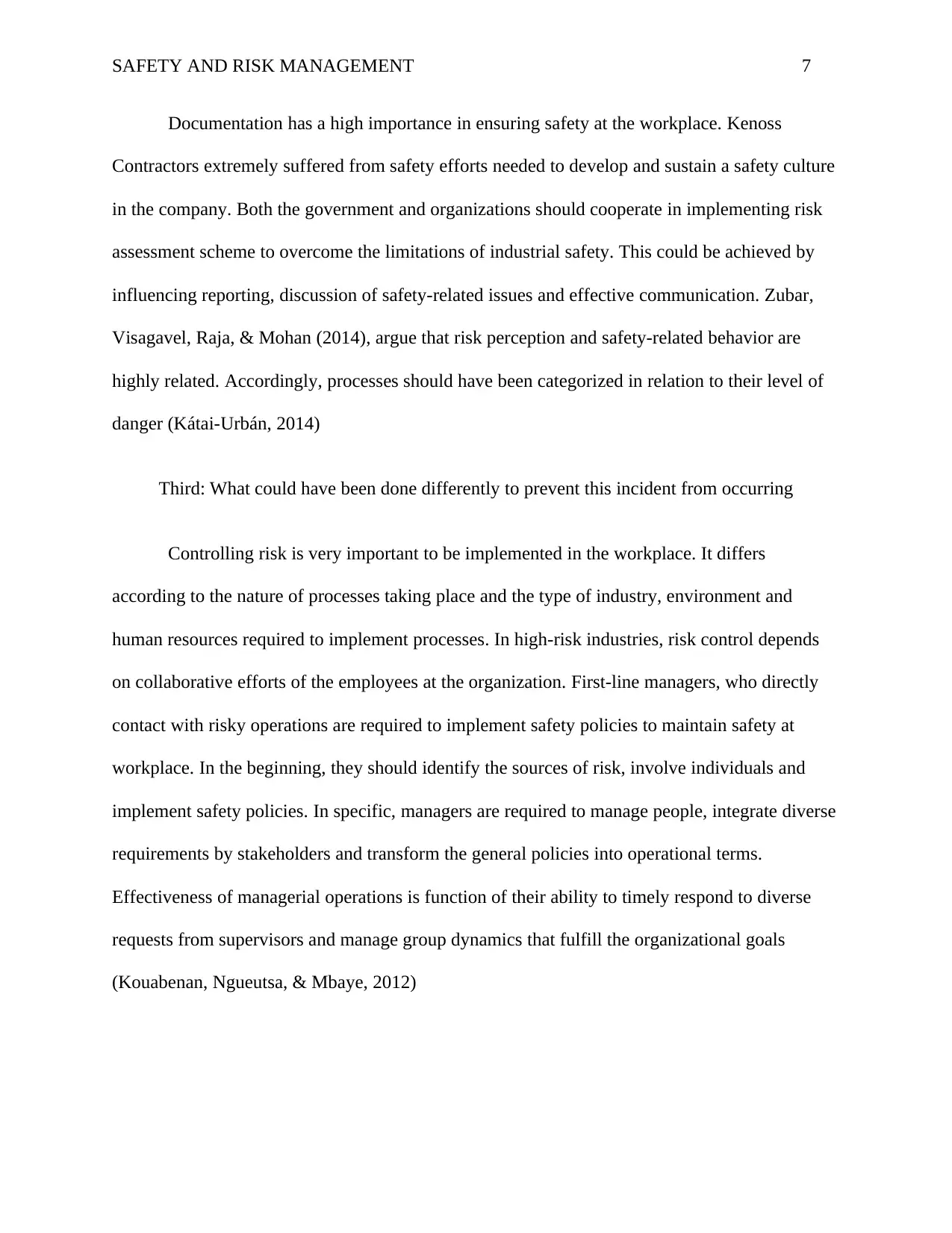
SAFETY AND RISK MANAGEMENT 7
Documentation has a high importance in ensuring safety at the workplace. Kenoss
Contractors extremely suffered from safety efforts needed to develop and sustain a safety culture
in the company. Both the government and organizations should cooperate in implementing risk
assessment scheme to overcome the limitations of industrial safety. This could be achieved by
influencing reporting, discussion of safety-related issues and effective communication. Zubar,
Visagavel, Raja, & Mohan (2014), argue that risk perception and safety-related behavior are
highly related. Accordingly, processes should have been categorized in relation to their level of
danger (Kátai-Urbán, 2014)
Third: What could have been done differently to prevent this incident from occurring
Controlling risk is very important to be implemented in the workplace. It differs
according to the nature of processes taking place and the type of industry, environment and
human resources required to implement processes. In high-risk industries, risk control depends
on collaborative efforts of the employees at the organization. First-line managers, who directly
contact with risky operations are required to implement safety policies to maintain safety at
workplace. In the beginning, they should identify the sources of risk, involve individuals and
implement safety policies. In specific, managers are required to manage people, integrate diverse
requirements by stakeholders and transform the general policies into operational terms.
Effectiveness of managerial operations is function of their ability to timely respond to diverse
requests from supervisors and manage group dynamics that fulfill the organizational goals
(Kouabenan, Ngueutsa, & Mbaye, 2012)
Documentation has a high importance in ensuring safety at the workplace. Kenoss
Contractors extremely suffered from safety efforts needed to develop and sustain a safety culture
in the company. Both the government and organizations should cooperate in implementing risk
assessment scheme to overcome the limitations of industrial safety. This could be achieved by
influencing reporting, discussion of safety-related issues and effective communication. Zubar,
Visagavel, Raja, & Mohan (2014), argue that risk perception and safety-related behavior are
highly related. Accordingly, processes should have been categorized in relation to their level of
danger (Kátai-Urbán, 2014)
Third: What could have been done differently to prevent this incident from occurring
Controlling risk is very important to be implemented in the workplace. It differs
according to the nature of processes taking place and the type of industry, environment and
human resources required to implement processes. In high-risk industries, risk control depends
on collaborative efforts of the employees at the organization. First-line managers, who directly
contact with risky operations are required to implement safety policies to maintain safety at
workplace. In the beginning, they should identify the sources of risk, involve individuals and
implement safety policies. In specific, managers are required to manage people, integrate diverse
requirements by stakeholders and transform the general policies into operational terms.
Effectiveness of managerial operations is function of their ability to timely respond to diverse
requests from supervisors and manage group dynamics that fulfill the organizational goals
(Kouabenan, Ngueutsa, & Mbaye, 2012)
Paraphrase This Document
Need a fresh take? Get an instant paraphrase of this document with our AI Paraphraser
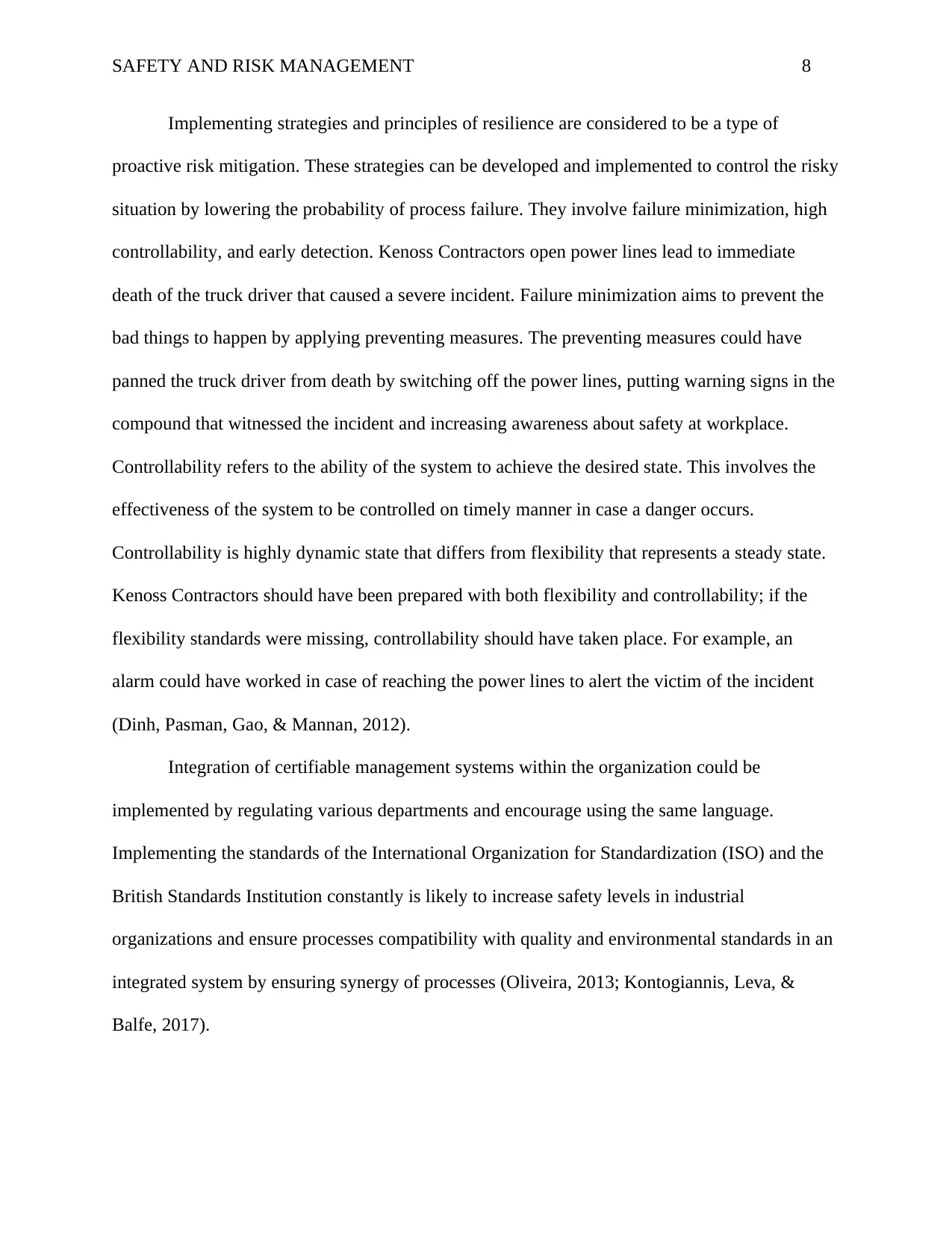
SAFETY AND RISK MANAGEMENT 8
Implementing strategies and principles of resilience are considered to be a type of
proactive risk mitigation. These strategies can be developed and implemented to control the risky
situation by lowering the probability of process failure. They involve failure minimization, high
controllability, and early detection. Kenoss Contractors open power lines lead to immediate
death of the truck driver that caused a severe incident. Failure minimization aims to prevent the
bad things to happen by applying preventing measures. The preventing measures could have
panned the truck driver from death by switching off the power lines, putting warning signs in the
compound that witnessed the incident and increasing awareness about safety at workplace.
Controllability refers to the ability of the system to achieve the desired state. This involves the
effectiveness of the system to be controlled on timely manner in case a danger occurs.
Controllability is highly dynamic state that differs from flexibility that represents a steady state.
Kenoss Contractors should have been prepared with both flexibility and controllability; if the
flexibility standards were missing, controllability should have taken place. For example, an
alarm could have worked in case of reaching the power lines to alert the victim of the incident
(Dinh, Pasman, Gao, & Mannan, 2012).
Integration of certifiable management systems within the organization could be
implemented by regulating various departments and encourage using the same language.
Implementing the standards of the International Organization for Standardization (ISO) and the
British Standards Institution constantly is likely to increase safety levels in industrial
organizations and ensure processes compatibility with quality and environmental standards in an
integrated system by ensuring synergy of processes (Oliveira, 2013; Kontogiannis, Leva, &
Balfe, 2017).
Implementing strategies and principles of resilience are considered to be a type of
proactive risk mitigation. These strategies can be developed and implemented to control the risky
situation by lowering the probability of process failure. They involve failure minimization, high
controllability, and early detection. Kenoss Contractors open power lines lead to immediate
death of the truck driver that caused a severe incident. Failure minimization aims to prevent the
bad things to happen by applying preventing measures. The preventing measures could have
panned the truck driver from death by switching off the power lines, putting warning signs in the
compound that witnessed the incident and increasing awareness about safety at workplace.
Controllability refers to the ability of the system to achieve the desired state. This involves the
effectiveness of the system to be controlled on timely manner in case a danger occurs.
Controllability is highly dynamic state that differs from flexibility that represents a steady state.
Kenoss Contractors should have been prepared with both flexibility and controllability; if the
flexibility standards were missing, controllability should have taken place. For example, an
alarm could have worked in case of reaching the power lines to alert the victim of the incident
(Dinh, Pasman, Gao, & Mannan, 2012).
Integration of certifiable management systems within the organization could be
implemented by regulating various departments and encourage using the same language.
Implementing the standards of the International Organization for Standardization (ISO) and the
British Standards Institution constantly is likely to increase safety levels in industrial
organizations and ensure processes compatibility with quality and environmental standards in an
integrated system by ensuring synergy of processes (Oliveira, 2013; Kontogiannis, Leva, &
Balfe, 2017).
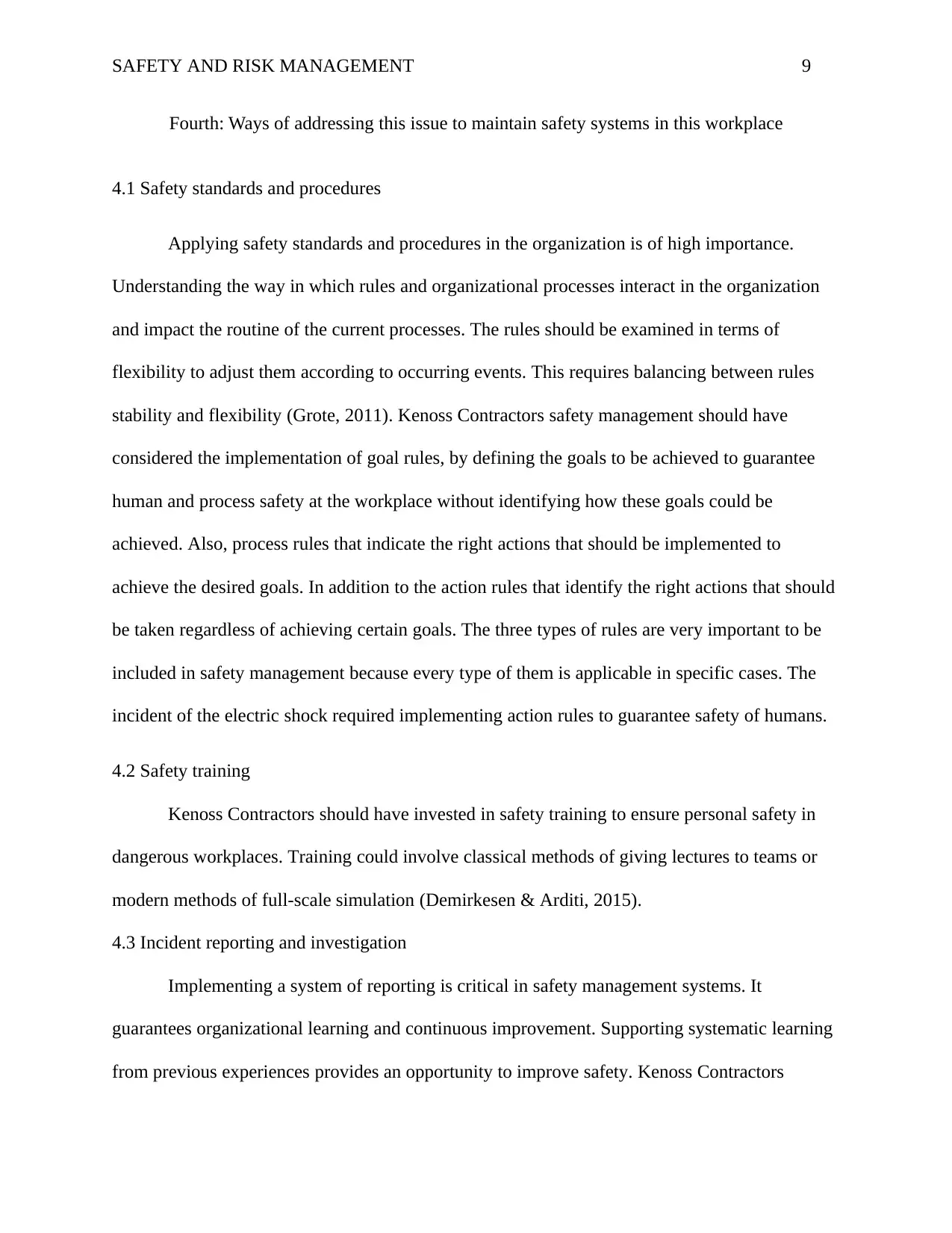
SAFETY AND RISK MANAGEMENT 9
Fourth: Ways of addressing this issue to maintain safety systems in this workplace
4.1 Safety standards and procedures
Applying safety standards and procedures in the organization is of high importance.
Understanding the way in which rules and organizational processes interact in the organization
and impact the routine of the current processes. The rules should be examined in terms of
flexibility to adjust them according to occurring events. This requires balancing between rules
stability and flexibility (Grote, 2011). Kenoss Contractors safety management should have
considered the implementation of goal rules, by defining the goals to be achieved to guarantee
human and process safety at the workplace without identifying how these goals could be
achieved. Also, process rules that indicate the right actions that should be implemented to
achieve the desired goals. In addition to the action rules that identify the right actions that should
be taken regardless of achieving certain goals. The three types of rules are very important to be
included in safety management because every type of them is applicable in specific cases. The
incident of the electric shock required implementing action rules to guarantee safety of humans.
4.2 Safety training
Kenoss Contractors should have invested in safety training to ensure personal safety in
dangerous workplaces. Training could involve classical methods of giving lectures to teams or
modern methods of full-scale simulation (Demirkesen & Arditi, 2015).
4.3 Incident reporting and investigation
Implementing a system of reporting is critical in safety management systems. It
guarantees organizational learning and continuous improvement. Supporting systematic learning
from previous experiences provides an opportunity to improve safety. Kenoss Contractors
Fourth: Ways of addressing this issue to maintain safety systems in this workplace
4.1 Safety standards and procedures
Applying safety standards and procedures in the organization is of high importance.
Understanding the way in which rules and organizational processes interact in the organization
and impact the routine of the current processes. The rules should be examined in terms of
flexibility to adjust them according to occurring events. This requires balancing between rules
stability and flexibility (Grote, 2011). Kenoss Contractors safety management should have
considered the implementation of goal rules, by defining the goals to be achieved to guarantee
human and process safety at the workplace without identifying how these goals could be
achieved. Also, process rules that indicate the right actions that should be implemented to
achieve the desired goals. In addition to the action rules that identify the right actions that should
be taken regardless of achieving certain goals. The three types of rules are very important to be
included in safety management because every type of them is applicable in specific cases. The
incident of the electric shock required implementing action rules to guarantee safety of humans.
4.2 Safety training
Kenoss Contractors should have invested in safety training to ensure personal safety in
dangerous workplaces. Training could involve classical methods of giving lectures to teams or
modern methods of full-scale simulation (Demirkesen & Arditi, 2015).
4.3 Incident reporting and investigation
Implementing a system of reporting is critical in safety management systems. It
guarantees organizational learning and continuous improvement. Supporting systematic learning
from previous experiences provides an opportunity to improve safety. Kenoss Contractors
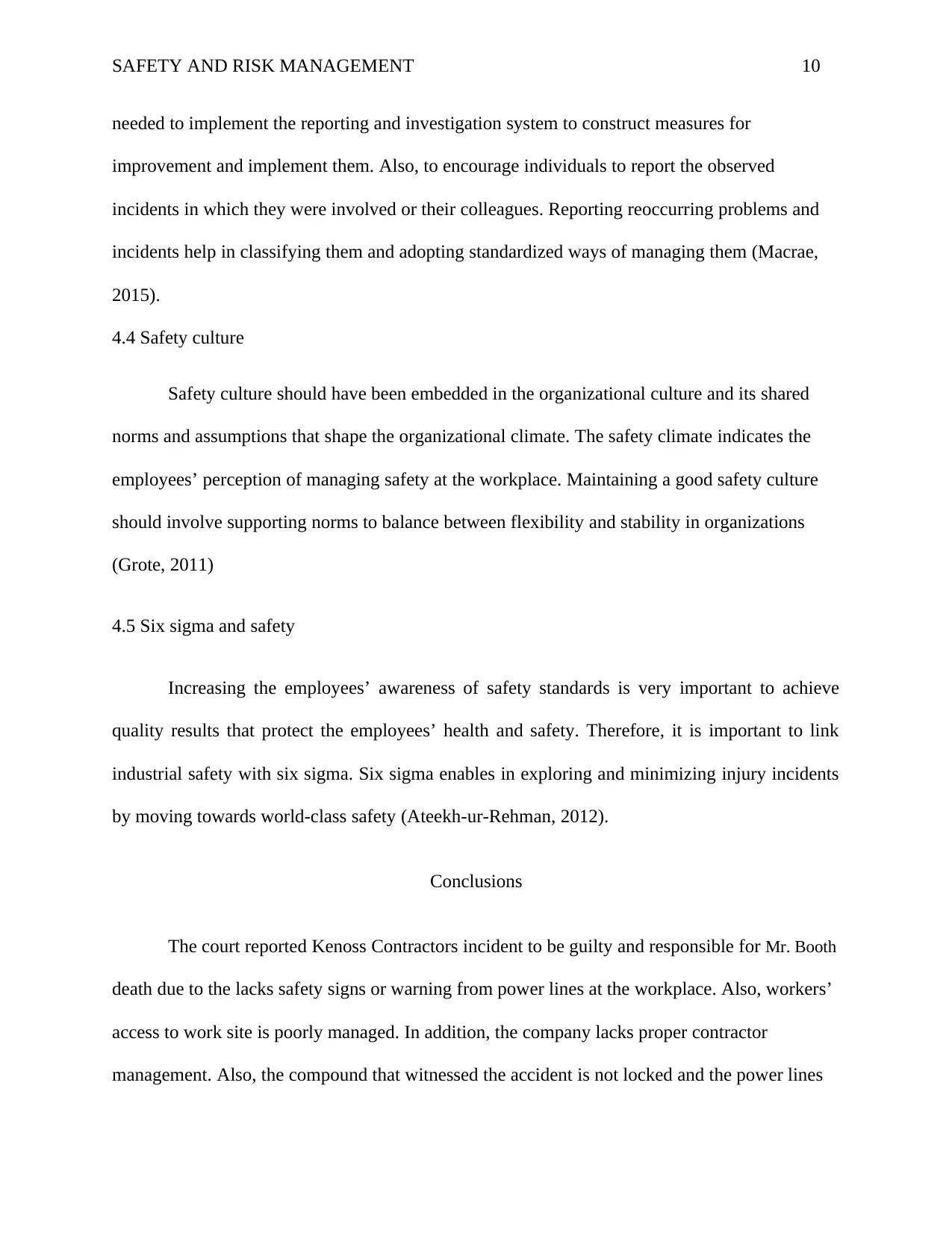
SAFETY AND RISK MANAGEMENT 10
needed to implement the reporting and investigation system to construct measures for
improvement and implement them. Also, to encourage individuals to report the observed
incidents in which they were involved or their colleagues. Reporting reoccurring problems and
incidents help in classifying them and adopting standardized ways of managing them (Macrae,
2015).
4.4 Safety culture
Safety culture should have been embedded in the organizational culture and its shared
norms and assumptions that shape the organizational climate. The safety climate indicates the
employees’ perception of managing safety at the workplace. Maintaining a good safety culture
should involve supporting norms to balance between flexibility and stability in organizations
(Grote, 2011)
4.5 Six sigma and safety
Increasing the employees’ awareness of safety standards is very important to achieve
quality results that protect the employees’ health and safety. Therefore, it is important to link
industrial safety with six sigma. Six sigma enables in exploring and minimizing injury incidents
by moving towards world-class safety (Ateekh-ur-Rehman, 2012).
Conclusions
The court reported Kenoss Contractors incident to be guilty and responsible for Mr. Booth
death due to the lacks safety signs or warning from power lines at the workplace. Also, workers’
access to work site is poorly managed. In addition, the company lacks proper contractor
management. Also, the compound that witnessed the accident is not locked and the power lines
needed to implement the reporting and investigation system to construct measures for
improvement and implement them. Also, to encourage individuals to report the observed
incidents in which they were involved or their colleagues. Reporting reoccurring problems and
incidents help in classifying them and adopting standardized ways of managing them (Macrae,
2015).
4.4 Safety culture
Safety culture should have been embedded in the organizational culture and its shared
norms and assumptions that shape the organizational climate. The safety climate indicates the
employees’ perception of managing safety at the workplace. Maintaining a good safety culture
should involve supporting norms to balance between flexibility and stability in organizations
(Grote, 2011)
4.5 Six sigma and safety
Increasing the employees’ awareness of safety standards is very important to achieve
quality results that protect the employees’ health and safety. Therefore, it is important to link
industrial safety with six sigma. Six sigma enables in exploring and minimizing injury incidents
by moving towards world-class safety (Ateekh-ur-Rehman, 2012).
Conclusions
The court reported Kenoss Contractors incident to be guilty and responsible for Mr. Booth
death due to the lacks safety signs or warning from power lines at the workplace. Also, workers’
access to work site is poorly managed. In addition, the company lacks proper contractor
management. Also, the compound that witnessed the accident is not locked and the power lines
Secure Best Marks with AI Grader
Need help grading? Try our AI Grader for instant feedback on your assignments.
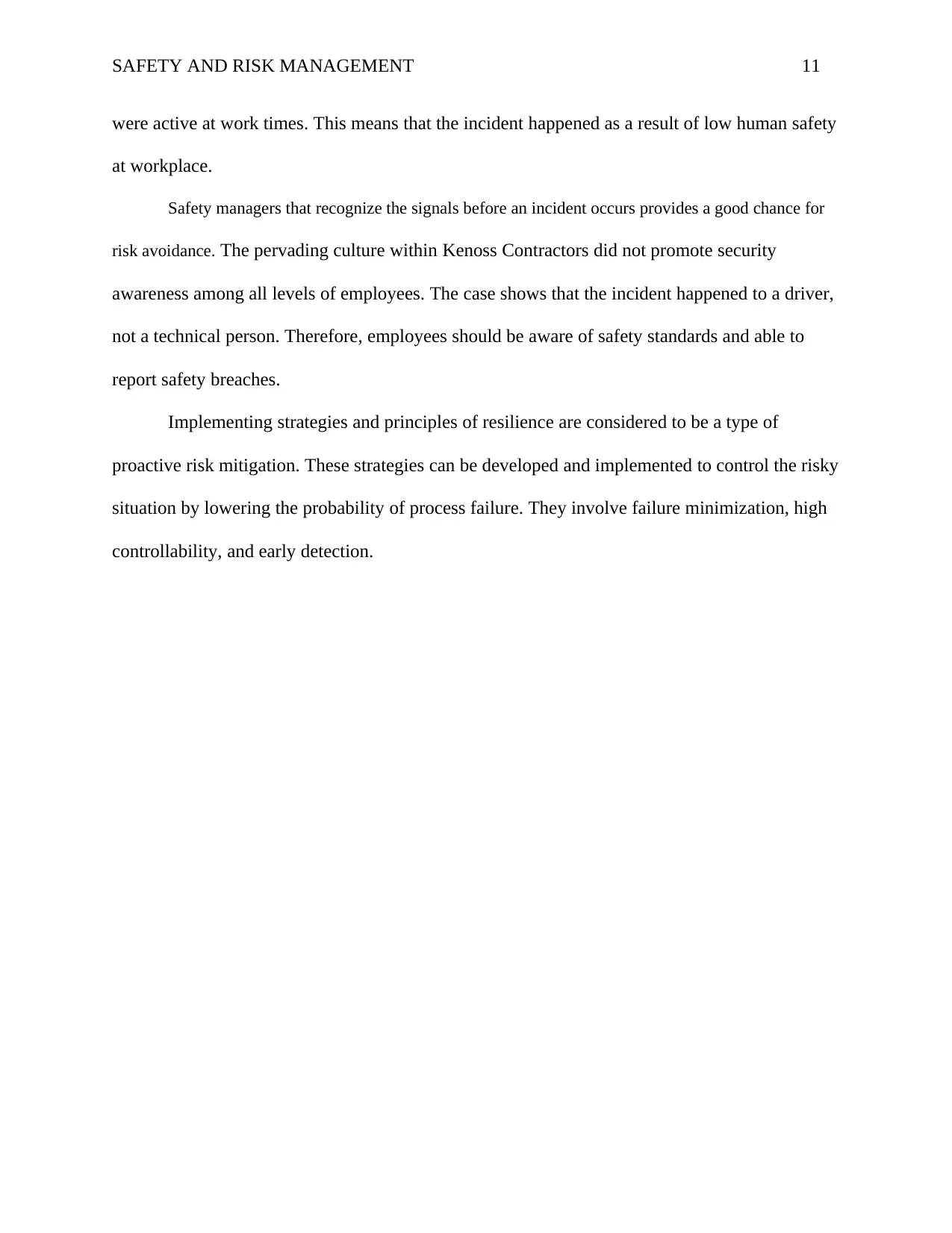
SAFETY AND RISK MANAGEMENT 11
were active at work times. This means that the incident happened as a result of low human safety
at workplace.
Safety managers that recognize the signals before an incident occurs provides a good chance for
risk avoidance. The pervading culture within Kenoss Contractors did not promote security
awareness among all levels of employees. The case shows that the incident happened to a driver,
not a technical person. Therefore, employees should be aware of safety standards and able to
report safety breaches.
Implementing strategies and principles of resilience are considered to be a type of
proactive risk mitigation. These strategies can be developed and implemented to control the risky
situation by lowering the probability of process failure. They involve failure minimization, high
controllability, and early detection.
were active at work times. This means that the incident happened as a result of low human safety
at workplace.
Safety managers that recognize the signals before an incident occurs provides a good chance for
risk avoidance. The pervading culture within Kenoss Contractors did not promote security
awareness among all levels of employees. The case shows that the incident happened to a driver,
not a technical person. Therefore, employees should be aware of safety standards and able to
report safety breaches.
Implementing strategies and principles of resilience are considered to be a type of
proactive risk mitigation. These strategies can be developed and implemented to control the risky
situation by lowering the probability of process failure. They involve failure minimization, high
controllability, and early detection.
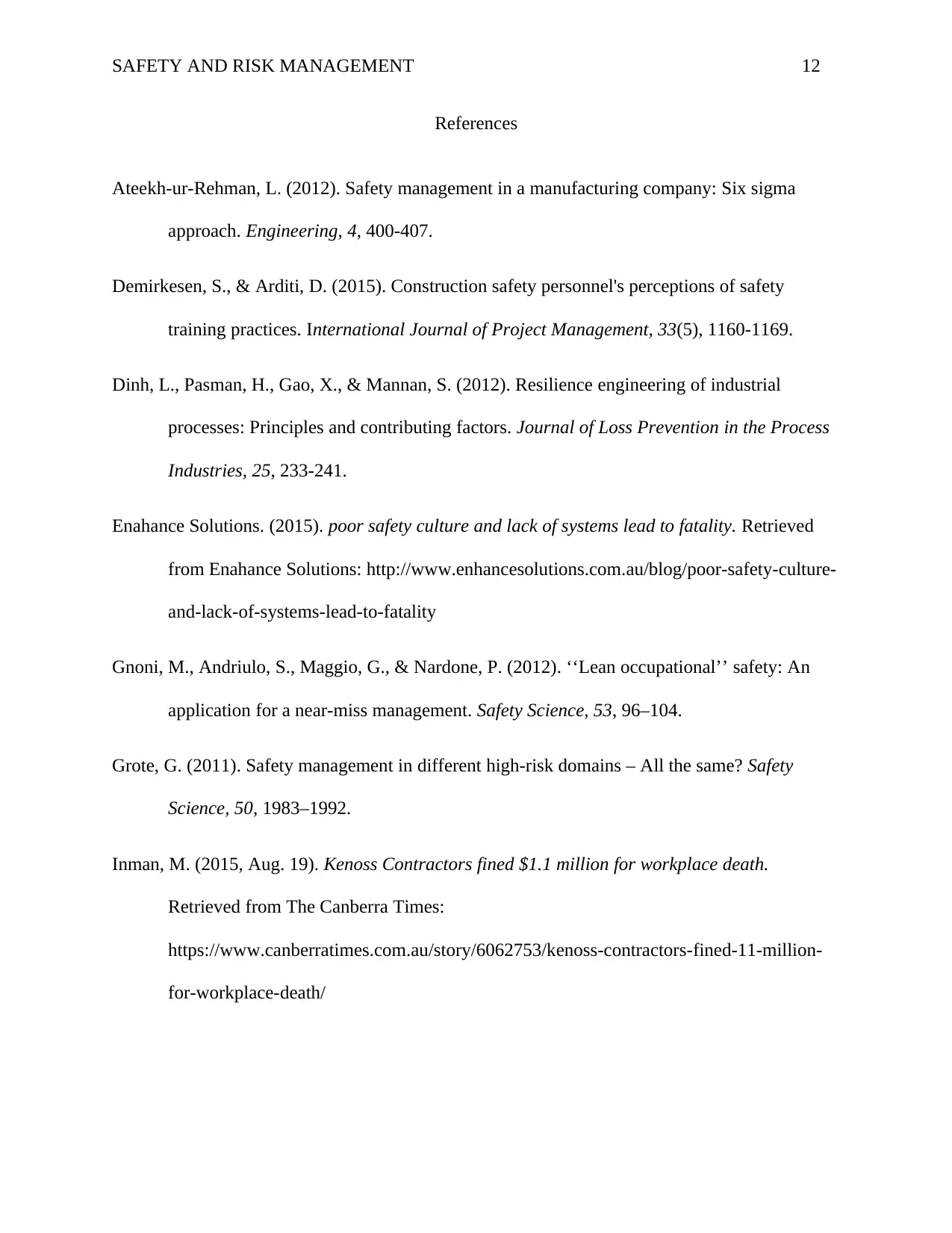
SAFETY AND RISK MANAGEMENT 12
References
Ateekh-ur-Rehman, L. (2012). Safety management in a manufacturing company: Six sigma
approach. Engineering, 4, 400-407.
Demirkesen, S., & Arditi, D. (2015). Construction safety personnel's perceptions of safety
training practices. International Journal of Project Management, 33(5), 1160-1169.
Dinh, L., Pasman, H., Gao, X., & Mannan, S. (2012). Resilience engineering of industrial
processes: Principles and contributing factors. Journal of Loss Prevention in the Process
Industries, 25, 233-241.
Enahance Solutions. (2015). poor safety culture and lack of systems lead to fatality. Retrieved
from Enahance Solutions: http://www.enhancesolutions.com.au/blog/poor-safety-culture-
and-lack-of-systems-lead-to-fatality
Gnoni, M., Andriulo, S., Maggio, G., & Nardone, P. (2012). ‘‘Lean occupational’’ safety: An
application for a near-miss management. Safety Science, 53, 96–104.
Grote, G. (2011). Safety management in different high-risk domains – All the same? Safety
Science, 50, 1983–1992.
Inman, M. (2015, Aug. 19). Kenoss Contractors fined $1.1 million for workplace death.
Retrieved from The Canberra Times:
https://www.canberratimes.com.au/story/6062753/kenoss-contractors-fined-11-million-
for-workplace-death/
References
Ateekh-ur-Rehman, L. (2012). Safety management in a manufacturing company: Six sigma
approach. Engineering, 4, 400-407.
Demirkesen, S., & Arditi, D. (2015). Construction safety personnel's perceptions of safety
training practices. International Journal of Project Management, 33(5), 1160-1169.
Dinh, L., Pasman, H., Gao, X., & Mannan, S. (2012). Resilience engineering of industrial
processes: Principles and contributing factors. Journal of Loss Prevention in the Process
Industries, 25, 233-241.
Enahance Solutions. (2015). poor safety culture and lack of systems lead to fatality. Retrieved
from Enahance Solutions: http://www.enhancesolutions.com.au/blog/poor-safety-culture-
and-lack-of-systems-lead-to-fatality
Gnoni, M., Andriulo, S., Maggio, G., & Nardone, P. (2012). ‘‘Lean occupational’’ safety: An
application for a near-miss management. Safety Science, 53, 96–104.
Grote, G. (2011). Safety management in different high-risk domains – All the same? Safety
Science, 50, 1983–1992.
Inman, M. (2015, Aug. 19). Kenoss Contractors fined $1.1 million for workplace death.
Retrieved from The Canberra Times:
https://www.canberratimes.com.au/story/6062753/kenoss-contractors-fined-11-million-
for-workplace-death/
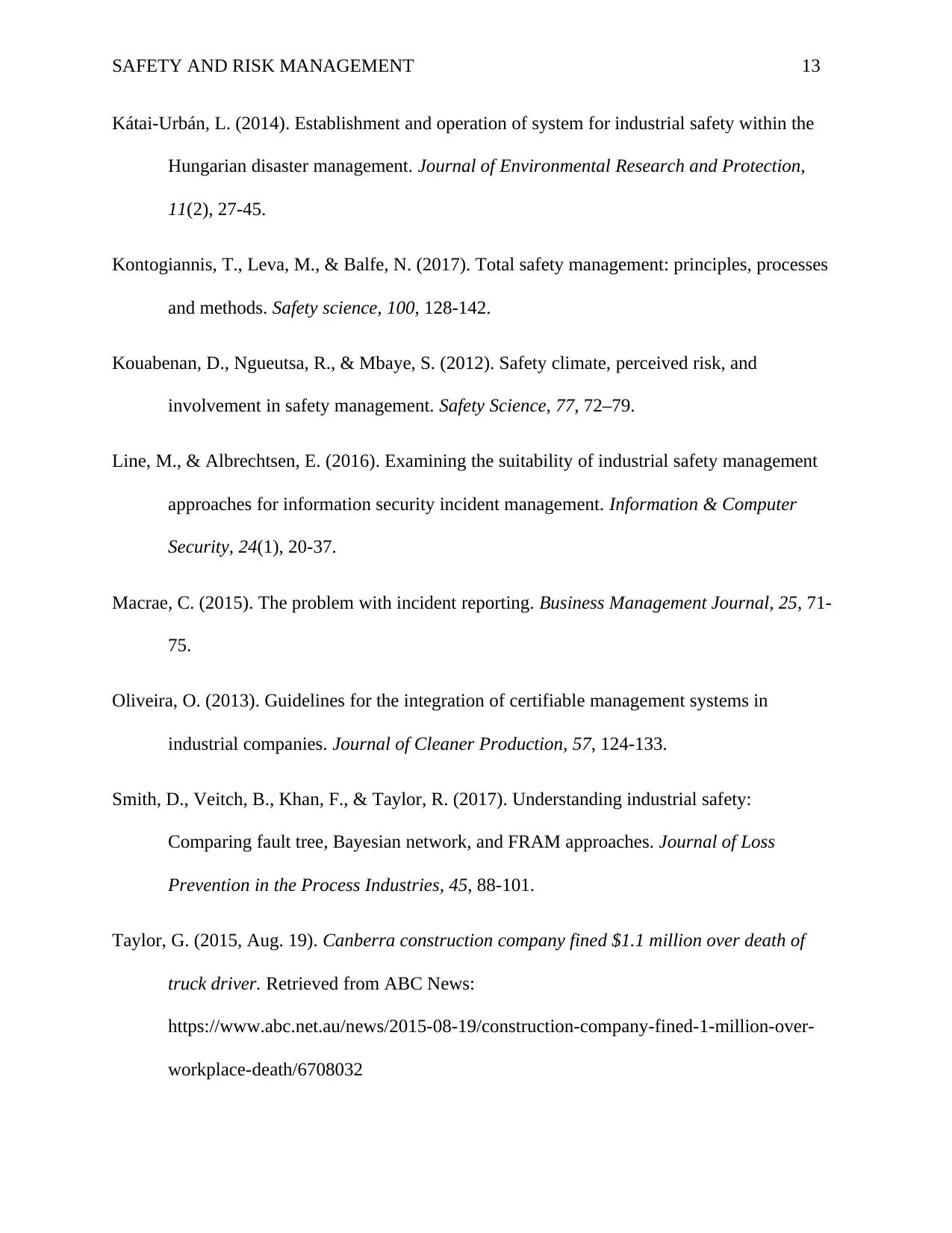
SAFETY AND RISK MANAGEMENT 13
Kátai-Urbán, L. (2014). Establishment and operation of system for industrial safety within the
Hungarian disaster management. Journal of Environmental Research and Protection,
11(2), 27-45.
Kontogiannis, T., Leva, M., & Balfe, N. (2017). Total safety management: principles, processes
and methods. Safety science, 100, 128-142.
Kouabenan, D., Ngueutsa, R., & Mbaye, S. (2012). Safety climate, perceived risk, and
involvement in safety management. Safety Science, 77, 72–79.
Line, M., & Albrechtsen, E. (2016). Examining the suitability of industrial safety management
approaches for information security incident management. Information & Computer
Security, 24(1), 20-37.
Macrae, C. (2015). The problem with incident reporting. Business Management Journal, 25, 71-
75.
Oliveira, O. (2013). Guidelines for the integration of certifiable management systems in
industrial companies. Journal of Cleaner Production, 57, 124-133.
Smith, D., Veitch, B., Khan, F., & Taylor, R. (2017). Understanding industrial safety:
Comparing fault tree, Bayesian network, and FRAM approaches. Journal of Loss
Prevention in the Process Industries, 45, 88-101.
Taylor, G. (2015, Aug. 19). Canberra construction company fined $1.1 million over death of
truck driver. Retrieved from ABC News:
https://www.abc.net.au/news/2015-08-19/construction-company-fined-1-million-over-
workplace-death/6708032
Kátai-Urbán, L. (2014). Establishment and operation of system for industrial safety within the
Hungarian disaster management. Journal of Environmental Research and Protection,
11(2), 27-45.
Kontogiannis, T., Leva, M., & Balfe, N. (2017). Total safety management: principles, processes
and methods. Safety science, 100, 128-142.
Kouabenan, D., Ngueutsa, R., & Mbaye, S. (2012). Safety climate, perceived risk, and
involvement in safety management. Safety Science, 77, 72–79.
Line, M., & Albrechtsen, E. (2016). Examining the suitability of industrial safety management
approaches for information security incident management. Information & Computer
Security, 24(1), 20-37.
Macrae, C. (2015). The problem with incident reporting. Business Management Journal, 25, 71-
75.
Oliveira, O. (2013). Guidelines for the integration of certifiable management systems in
industrial companies. Journal of Cleaner Production, 57, 124-133.
Smith, D., Veitch, B., Khan, F., & Taylor, R. (2017). Understanding industrial safety:
Comparing fault tree, Bayesian network, and FRAM approaches. Journal of Loss
Prevention in the Process Industries, 45, 88-101.
Taylor, G. (2015, Aug. 19). Canberra construction company fined $1.1 million over death of
truck driver. Retrieved from ABC News:
https://www.abc.net.au/news/2015-08-19/construction-company-fined-1-million-over-
workplace-death/6708032
Paraphrase This Document
Need a fresh take? Get an instant paraphrase of this document with our AI Paraphraser
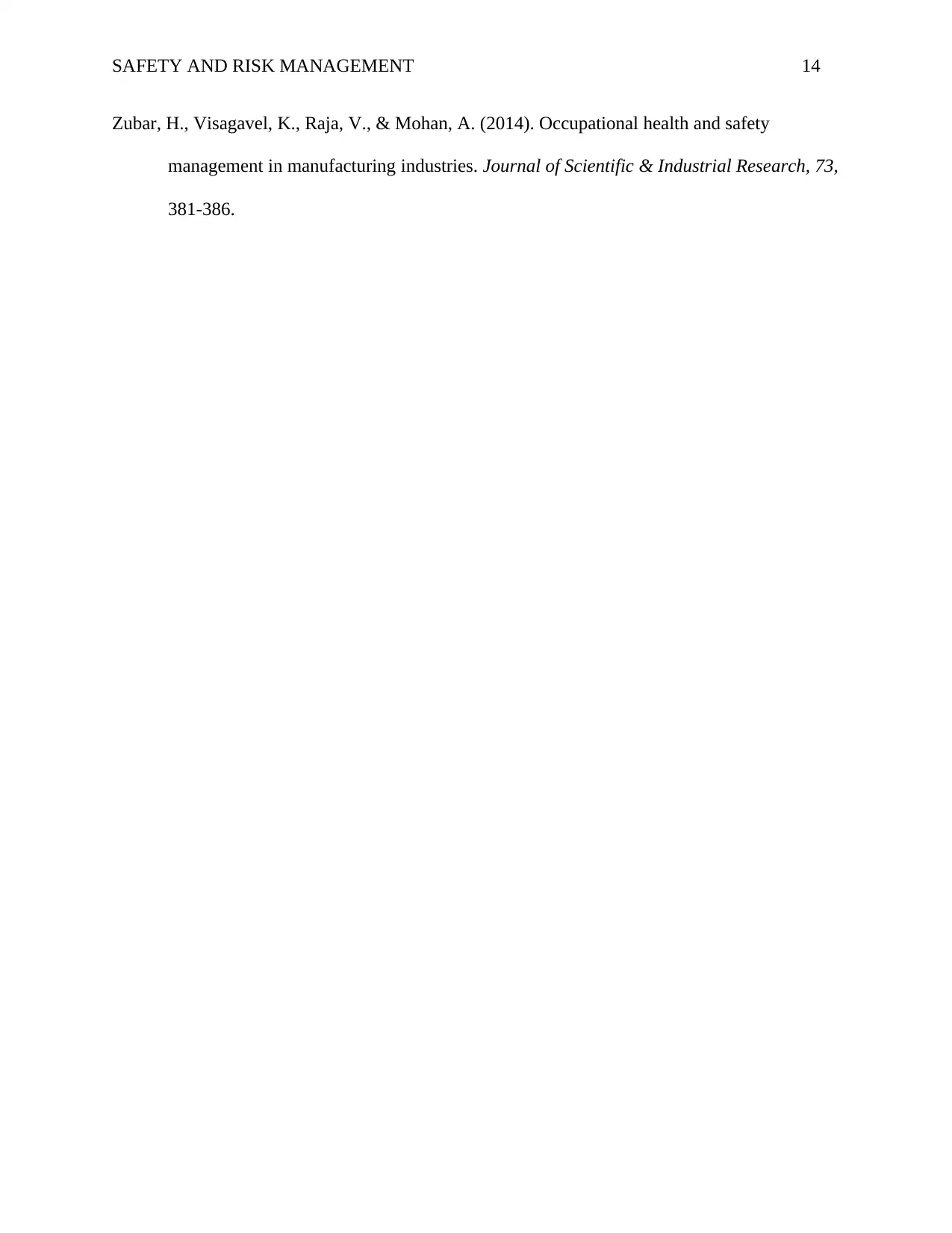
SAFETY AND RISK MANAGEMENT 14
Zubar, H., Visagavel, K., Raja, V., & Mohan, A. (2014). Occupational health and safety
management in manufacturing industries. Journal of Scientific & Industrial Research, 73,
381-386.
Zubar, H., Visagavel, K., Raja, V., & Mohan, A. (2014). Occupational health and safety
management in manufacturing industries. Journal of Scientific & Industrial Research, 73,
381-386.
1 out of 14
Related Documents
Your All-in-One AI-Powered Toolkit for Academic Success.
+13062052269
info@desklib.com
Available 24*7 on WhatsApp / Email
![[object Object]](/_next/static/media/star-bottom.7253800d.svg)
Unlock your academic potential
© 2024 | Zucol Services PVT LTD | All rights reserved.




